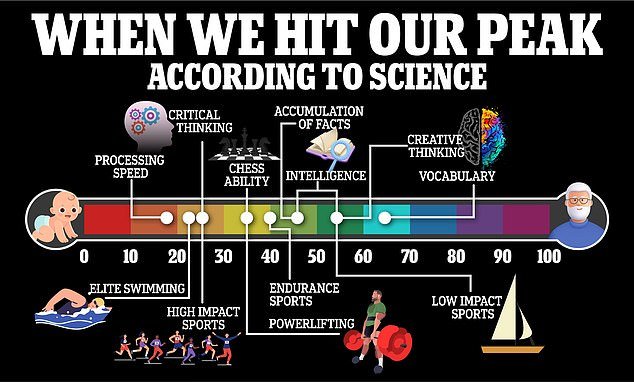The Daily Observer London Desk: Reporter- John Furner
When it comes to reaching your mental and physical peak, the fountain of youth is not all it’s cracked up to be.
That’s according to the most current research and thorough analysis from a wide range of influential economists, scientists, and psychologists.
It shows that the peak decade for performance in endurance sports like marathon running and sailing is in your forties.
But the average athlete in high-impact sports such as sprinting and football reach their prime at around 25.
In terms of mental acuity, people hit their peak vocabulary at around 65, while overall intelligence and knowledge are at their best in your 40s and 50s.
The estimated ages at which people reach peak performance were gleaned from a wide body of research conducted by scientists, psychologists, and economists
When someone ‘peaks’ at a certain age, it means they have reached the pinnacle of their abilities in a particular area, including physical fitness and mental acuity.
The term ‘peak’ is often used to describe a person who excelled in high school or college but whose achievements after graduation were far less impressive, but in reality, humans’ abilities to perform best in athletics or cognitive exercises like chess vary greatly by age.
A first-class athlete in his 20s who specializes in speed and power exercises such as sprinting will typically perform better than an older competitor, while marathon runners and other endurance athletes tend to reach their peak by age 40.
Sports that require explosive power within a short period of time, such as sprinting, gymnastics, speed skating, and fast-paced competitive swimming rely on fast-twitch muscle fibers that make up skeletal muscles – the most common in the body that assist in everyday activities.
This type of muscle generates powerful, rapid contractions to create a burst of explosive energy. Fast-twitch muscles rely on a type of energy production that does not require as much oxygen. These muscles are important in high-energy sports when the need for a burst of power exceeds a need for oxygen.
But as a person ages, those fast-twitch muscle fibers begin to atrophy, making it more difficult to run or swim as fast as younger competitors.
That’s why adults in their middle-age excel at endurance feats such as long-distance running and cycling. Those activities use slow-twitch muscle fibers which rely heavily on oxygen to generate energy for continuous muscle contractions over a longer span of time.
And slow-twitch muscles can grow, especially as a person keeps training in sports that rely on a more sustained form of energy.
In a person’s later years creativity and innovation, characteristics that people often associate with youth, can reach their peaks. But not all thinking skills and patterns peak at the same age.
The ages at which people peak in different skills such as thinking outside the box in search of creative solutions or high-impact sports such as basketball, football, or track vary substantially by age, with older adults excelling in the former and young adults are best suited to the latter.
Creativity and athletic prowess are often associated with youth.
Young people possess rich imaginations and an openness to hearing different human experiences. But a growing body of research suggests that this is not a hard and fast rule.
Older people are most skilled at ‘experimental’ thinking which reflects years of accumulated knowledge, education, and experience.
Experimental thinkers, whose skills peak in mid-50s, are able to generate a lot of possibilities for a range of different situations by thinking outside the box. This usually results in imaginative solutions to problems.
Experimental thinking is especially important in the field of scientific research, in which the average age hovers around 46 to 55.
Scientific research demands consideration of a wide range of possibilities to explain a hypothesis as well as generate new ways to conduct research overall.
Another pattern of creative or innovative thinking is known as ‘conceptual’ thinking.
It helps people grapple with abstract ideas and reasoning that help with problem-solving and taking into consideration a range of perspectives.
People typically achieve their peak conceptual thinking abilities in young adulthood, around 25.
Peak ages for different forms of physical activity also vary substantially based on the level of intensity and amount of energy needed to perform best.
While it is true that outstanding sprinters and swimmers skew younger, around their mid-20s, endurance athletes such as marathon runners peak in their early 40s.
Adults typically reach their peak for performing low-impact exercises such as sailing and horseback riding in their 50s.
If the numbers of candles on the birthday cake tally higher than the ages of peak athletes and scholars, don’t despair, as people can peak in one endeavor while likely getting better in another.



